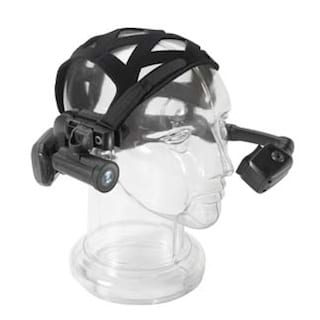 Imagine you’re elbow-deep in an especially tough mechanical repair. One hand is turning a screwdriver, the other is holding down a piece of equipment. Wouldn’t it be nice to Google-search for repair tips, hands-free?
Imagine you’re elbow-deep in an especially tough mechanical repair. One hand is turning a screwdriver, the other is holding down a piece of equipment. Wouldn’t it be nice to Google-search for repair tips, hands-free?
Or imagine you’re climbing up scaffolding (or up a radio tower) for a maintenance call. You can’t exactly take a rugged laptop up there with you, huh?
That’s where the Motorola HC1 comes in — or at least that’s the idea.
The HC1 is a wearable headset computer: a camera next to your ear shoots video of what you’re looking at, while a display just below the eye broadcasts images that appear to the eye like a 15-inch screen. The computer responds to head movements or vocal commands.
Per DC Velocity, “It’s the display pod that sets the HC1 apart from other headsets. By looking down into the pod, the user can see maps, schematics, or any other information he or she could access through a mobile device such as a smartphone or tablet computer. Users navigate through documents with a combination of voice commands and head gestures.”
Nicole Tricoukes, a Motorola rep, explained to DC Veloctity why field service was a natural fit for the futuristic head-computer.
“The field person could snap a picture and send the image to the remote expert. Then, the expert could annotate the image like a football play and send it back to the field associate,” she said.
The HC1 is set to go on sale in the first half of 2013, so while it sounds like something from 2001: A Space Odyssey, it may well show up in the field sooner than you think. (Starting price reportedly between $4,000 and $5,000.) The company is apparently targeting field technicians, as well as warehouse workers, and training and simulation operations as potential markets.
So, what do you think? It’s a little tough to get over the sci-fi element of this, but a wearable, hands-free computer definitely makes a certain amount of sense for repair techs. Also, it should be mentioned: We totally called this months ago.
More: Is Field Service the Perfect Market for Google Goggles?
Click here to download a free whitepaper, “Five Steps to Make Field Service Profitable.”

Share this: